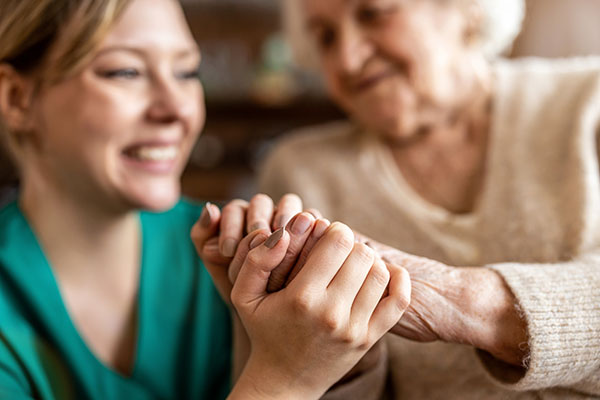People with dementia struggle to express their needs, thoughts, and feelings as their disease progresses. Understanding how to communicate effectively with people with dementia is vital for healthcare professionals in various settings, including home care, assisted living facilities, hospitals, and hospices.
As brain function degenerates, people with dementia gradually face difficulties finding words and organizing them into logical sentences. Often, they repeat themselves.
A patient’s ability to communicate affects care outcomes in multiple ways. A 2022 article in Cureus concludes, “Without effective communication, the quality of care delivered to patients may be impacted, resulting in increased healthcare costs, resource misallocation, and, in some cases, mortality. This is especially important in patients who have dementia because dementia is associated with a decline in cognitive and linguistic functions, making communication difficult.”
Making a connection
To understand people with dementia, your clinicians need to see things through the other person’s eyes. “You need to learn the art of going with their [the patients’] flow, and then you get it and have the chance to try something new,” said Teepa Snow, MS OTR/L, FAOTA, in a recent Relias webinar.
Snow shared verbal and nonverbal techniques to improve interactions with people with dementia.
- Start with the Positive Physical Approach. Developed by Teepa Snow, this approach to care includes the following steps:

- Pause at the edge of the public space (six feet).
- Gesture and greet the person by name.
- Offer your hand and make eye contact.
- Approach slowly within visual range.
- Shake hands and then maintain a hand-under-hand position.
- Move to the side.
- Get to eye level and respect intimate space.
- Wait for acknowledgment.
- Make a visual connection. Look interested and friendly.
- Make a verbal connection. Sound enthusiastic and keep responses short.
- Make a physical connection. Use the hand-under-hand position or a flat open hand on the forearm or knee.
Connecting emotionally
After establishing the initial connection with the individual you care for, Snow recommends starting a personal conversation. Here are a few tips:
- Identify common interests.
- Say something nice about the person or their living space.
- Share something about yourself and encourage the person to share back.
- Follow their lead and listen actively.
- Repeat some of their words back to keep the flow going.
- Use the phrase “Tell me about….”
When the person is distressed
If you notice that the person is distressed, sending them visual, verbal, and physical signals of connection is essential.
- Visual signal — Look concerned, not happy.
- Verbal signal — Use a tone of voice that matches theirs.
- Physical signal — If the person is not too angry, squeeze their hand lightly, offer an open palm on their shoulder or back, or hug them if they need more contact.
Supportive communication techniques
Listening to the person and offering empathy with the situation is essential. Validate their emotions and consider the stage of their dementia to respond appropriately.
- Early stage — You can use phrases like: “I’m so sorry this is happening to you.”
- Middle stage — Listen for more information, ideas, and thoughts they share.
- Last stage — Check their body and look at their face, posture, movements, and gestures. Look for what they are trying to communicate behind the words and actions.
If what you’re trying is not working, then stop, think it through, and try something slightly different.
While clinicians cannot stop brain function decline, they can develop skills that aid communication with people with dementia. Empowering your staff with knowledge will allow them to provide compassionate, respectful care. With advanced, competent techniques, they can turn challenging interactions into positive experiences for everyone involved — residents, families, caregivers, and clinicians.

How To Communicate With Someone Living With Dementia
Interactions with residents living with dementia may be challenging at times, but knowing how to respond effectively helps to create more positive experiences for all involved. Renowned dementia care expert, Teepa Snow, highlights verbal and nonverbal communication techniques that improve interactions.
Watch the Webinar →





